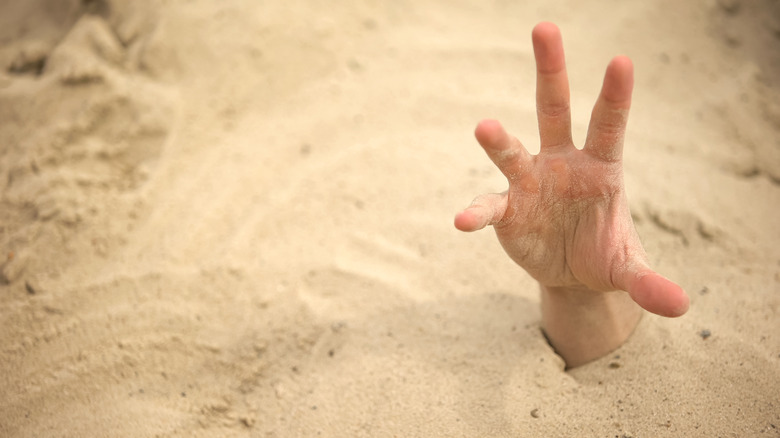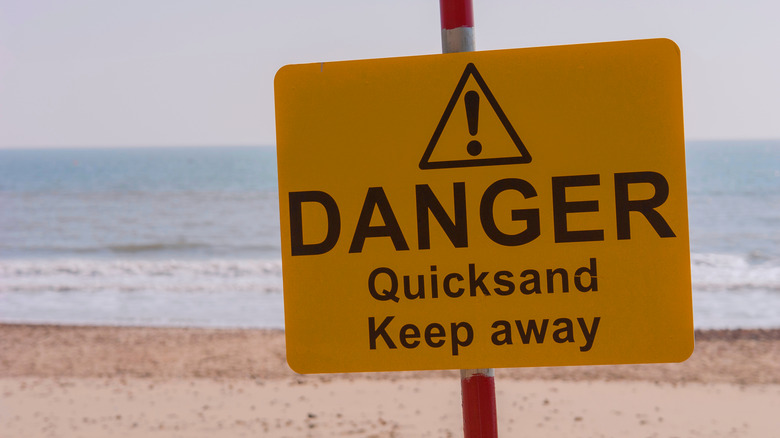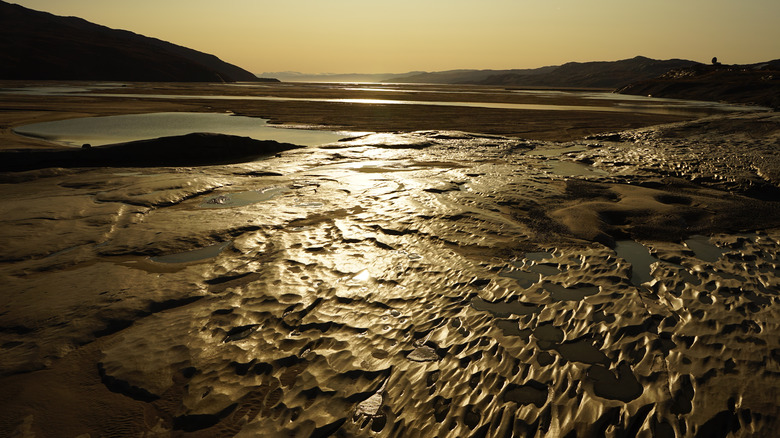It's Time To Stop Believing This Common Quicksand Myth
Quicksand was a common plot device in many adventure films of the 1980s and '90s from The Princess Bride to The Neverending Story. If you were a child at that time, due to seeing so much quicksand on the big screen, you had probably imagined that your adult life would involve more encounters with the stuff. In reality, most of us have never even seen quicksand let alone fell into it and almost died. As it turns out, the dangers of quicksand were largely overstated. In fact, the idea that someone can drown in quicksand is entirely a myth.
There are two reasons for this. Firstly, quicksand is almost never deeper than a few feet — which means, unless you dive into it face-first, it'd be kinda hard to drown. On top of that, the human body is naturally more buoyant than quicksand. As Encyclopedia Britannica explains, although our arms and legs are pretty dense and will sink, our chest cavity is full of air and will always float above the surface of quicksand. This means that even if the quicksand is deep enough to be a threat, you could only ever sink up to your waist.
Feeling like your childhood has been ruined? Not so fast. Quicksand may actually be deadly, but only in very rare and specific circumstances.
When quicksand is actually dangerous
While you may not be able to drown in quicksand, it is true that you can get stuck in it. In fact, according to a study published in Nature, the force required to pull someone out of certain types of quicksand is about equal to that necessary to lift a car. So, if you get stuck, you can't simply be pulled out by a friend (or by using your cool whip skills like Indiana Jones).
With that in mind, the real danger of quicksand comes down to its location. Although in movies quicksand is often depicted as a threat that can pop up in the middle of the jungle or desert. In reality, quicksand is only ever found in areas with moving water and — well — sand. These locations may include the mouth of a river, flat and wide stretches of streams or lakes, marshes, or beaches where water is pooling on the shore.
Being stuck in quicksand is usually not life-threatening but can become so if you are stuck in it for a long time and are exposed to cold temperatures or if you are trapped in an area that is submerged at high tide. A few quicksand deaths have occurred because of these reasons. However, the situation is so rare that there aren't any published statistics concerning how often it happens.
How to get out of quicksand in the unlikely event that you get stuck
Even though it is very unlikely that you will encounter quicksand, let alone get stuck in it, it's good to know what you should do in that situation — just in case. According to Encyclopedia Britannica, the best thing to do if you ever find yourself trapped in quicksand is to first get rid of any heavy items like backpacks or other bags. Then, if you aren't stuck too deep, try to take a few steps back to safety. However, one thing the movies got right about quicksand is that large movements can displace more sand and cause you to sink deeper. So, if stepping backward just causes your other leg to sink, you should stop moving immediately and assess the situation.
If you can't simply step to safety, the recommended strategy is to lean backward to try and lay flat on your back in order to distribute your weight more evenly across the area. This method may allow you to very slowly wiggle your legs back up to the surface essentially freeing you from the sand. Once you've accomplished this and are floating on your back on top of the quicksand, you can make small movements to swim your way back to safer ground.


